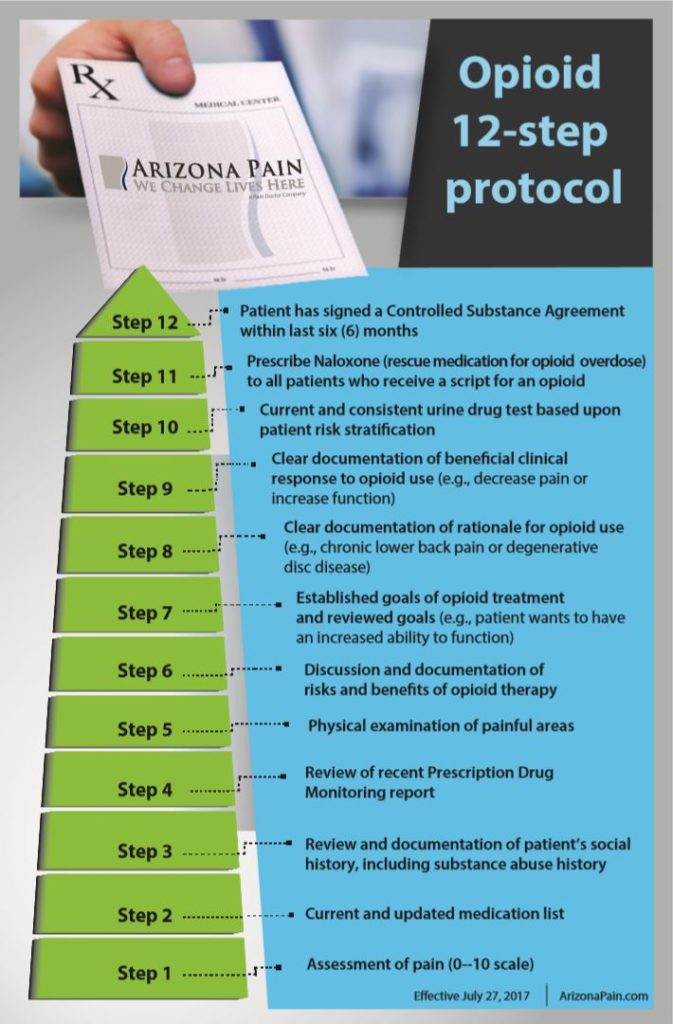Medication Management
Pain is a universal experience. But, when it becomes chronic, it interrupts work, recreation, and relationships. Pain medicine management is an important part of Arizona Pain’s approach to treating pain. When medication is part of your comprehensive treatment plan, we make sure it’s the right fit, even as your condition changes over time. We offer a variety of pharmacological options and take managing your pain medicine seriously. Here’s what you should know.
What are the tenets of pain medicine management?
Though it is universal, pain is so complex and subjective that it is difficult to treat. When a patient comes to our clinic with a chronic pain condition, we have several pharmacologic options available. Before we select medication for pain control, though, we first diagnose the type of pain a patient is experiencing.
Chronic pain falls most commonly into two categories:
- Nociceptive pain: Inflammation or injury to tissue
- Neuropathic pain: The result of injury or damage to the nerve itself
Anti-inflammatory and analgesic medications typically help with nociceptive pain. This includes non-steroidal anti-inflammatory drugs (NSAIDS) and opioids. Neuropathic pain, however, is treated differently using medications that act on neurotransmitters and nerves (e.g., antidepressants, anticonvulsant agents).
It is important to note that there can be overlap between these two categories. A broken bone may be so severe as to cause nerve damage. In this case, pain could be both nociceptive and neuropathic.
Our job as pain specialists is to prescribe the correct pain medications in an appropriate amount for pain relief with as few side effects as possible. We coordinate medications with other complementary treatments to reduce your overall dosage, when possible. It includes adjusting and modifying medications, and monitoring side effects and potential drug interactions.
Nociceptive pain medications
Nociceptive pain results from tissue damage. Injury to a specific area occurs, which causes neurons to report damage to your brain. You then experience pain.
Nociceptive pain is of two types:
- Somatic: In the skin, muscles, bones, and joints
- Visceral (gut): In the organs or thoracic and abdominal cavity
Nociceptive pain can be sharp, or it may be dull or aching. Nociceptive pain is generally responsive to and first treated with non-steroidal anti-inflammatory drugs (NSAIDs), followed with opioids for more severe or refractory pain. Conditions associated with inflammation, bone pain, and joint disease are particularly responsive to NSAIDs.
The following types of medications can help manage nociceptive pain.
Acetaminophen
Acetaminophen is an over-the-counter medication for pain and fever. It works on the parts of the brain that receive the pain messages. It does not have the anti-inflammatory effects of the non-steroidal anti-inflammatory drugs (NSAIDs) listed below. However, in cases of chronic pain, there is often no inflammation at the site of the pain, and thus Tylenol (a brand of acetaminophen) may be an appropriate treatment choice.
Tylenol is a safe medication with appropriate use. However, it can be very dangerous when used inappropriately. The risk of liver or kidney damage is significant when more than the recommended dose of Tylenol is used. If you have liver disease, acetaminophen should only be used under your doctor’s supervision.
Non-steroidal anti-inflammatory drugs (NSAIDs)
Many non-steroidal anti-inflammatory drugs (NSAIDs) are available over-the-counter without a prescription. These include:
- Aspirin
- Ibuprofen
- Ketoprofen
- Naproxen sodium
These medications relieve pain by reducing the production of prostaglandins. Prostaglandins are hormone-like substances that cause pain and inflammation. NSAIDs can be extremely effective at reducing inflammation. They are most beneficial in cases of acute pain (or pain flare-ups in patients with chronic pain).
In general, NSAIDs should not be used on a daily basis for the treatment of chronic pain. When used on a daily basis for a period of several years, there is a risk of damage to the kidneys.
Furthermore, there is a well-known risk of gastric ulcers with NSAIDs. While the newer COX2 inhibitors can help avoid this complication, use caution if you have a risk of ulcers or GI bleeding.
COX2 inhibitors
Recently, a new class of NSAIDs has become available: COX2 inhibitors. COX2 inhibitors have the benefit of pain and inflammation relief while minimizing the risk of GI toxicity and bleeding. The COX2 inhibitors are equally effective as other NSAIDS for inflammation but no better for pain relief.
Generally, these medications are more expensive than other over-the-counter NSAIDS. However, if GI bleeding is a concern, the total cost may be lower than adding another drug to counteract the side effects of NSAIDs.

Opioids
When treating chronic pain, narcotic opioids should be considered only if a patient’s pain cannot be otherwise controlled. Although opioids can be dangerous and addictive, they can also be effective when used appropriately.
An opioid is a chemical substance that has a morphine-like action in the body. The term opioid is derived from opium, which is an extract from the poppy plant. These agents have been available for centuries to relieve pain.
Opioids work by binding to opioid receptors, especially those in your central nervous system and the gastrointestinal tract.
All opioids have similar clinical effects. They can vary in potency, speed of onset, and duration of action. Both short- and long-acting formulations are available. Some opioids are used around-the-clock while others are used intermittently for breakthrough pain.
One common mistake when treating chronic pain with opioid medications is using the short-acting types of medication. While these medications are useful for acute pain, they can also cause sedation and euphoric side effects. The short-acting nature of these medications encourages overuse and the development of tolerance. Long-acting opioids may have fewer cognitive side effects and better control of chronic pain.
No adequate long-term studies have shown opioid’s effectiveness in the treatment of chronic nonmalignant pain, and they are not approved for this use. They also come with significant side effects that may include GI upset, nausea, disturbed sleep, constipation, and addiction. Studies show about 5-15% of chronic pain patients using narcotic pain medications develop dependence.
Atypical opioids
Considerable debate exists about the use of opioids for treatment of chronic pain of non-cancer origin. Many physicians feel that opioids can play an important role in the treatment of all types of chronic pain, including non-cancer pain. Others caution against the widespread use of opioids. They note problems with tolerance that leads to loss of benefit with time.
At Arizona Pain, we believe that the use of opioids (or for that matter any treatment) makes sense when the benefits outweigh the risks and negative side effects. This occurs when:
- There is a significant increase in the person’s level of functioning
- There is a reduction or elimination of pain complaints
- The patient experiences a more positive, hopeful attitude
- Side effects are minimal or controllable
The dilemma with the long-term use of opioids is that while there is a role for opioids in chronic, non-cancer pain, it is well-known that long-term use of opioids may result in the following damaging side effects:
- Tolerance
- Misuse
- Hyperalgesia (abnormal pain sensitivity)
- Hormonal effects (decreased testosterone levels, decreased libido and sex drive, and irregular menses)
- Depression
- Suppression of the immune system
While opioid treatment may be prescribed to reduce pain and improve function, the treatment may actually result in just the opposite. You can learn more about our opioid therapy statement here.

Neuropathic medications
Neuropathic pain occurs with injury to the nerve. Often this type of pain has the following symptoms:
- Burning sensations
- Increased sensitivity
- Shooting sensations
Patients often describe neuropathic pain as severe, sharp, lightning-like, stabbing, burning, numbness, tingling, or weakness.
Neuropathic pain has very different treatment approaches from other types of pain. Remedies for nociceptive pain (e.g., NSAIDs and opioids) simply do not work as well for neuropathic pain. Neuropathic pain responds best to membrane-stabilizing medications, including:
- Anticonvulsants
- Tricyclic antidepressants
- Select antidepressant medications
These medications act by blocking the brain’s neurotransmitters. The antidepressant medications also have beneficial effects of improved mood, decreased anxiety, and improved sleep cycle. These medications are not addictive and, when appropriately managed, have few side effects.
Anticonvulsants
Anticonvulsant medications can be divided into first- or second-generation agents. The second-generation medications are generally better tolerated and have fewer side effects than the first-generation agents.
Of the first-generation agents, carbamazepine can effectively trigeminal neuralgia. There is some evidence of relief for post-herpetic neuralgia and diabetic neuropathy as well. Carbamazepine’s main side effect is sedation.
Patients treated with carbamazepine should also have complete blood counts (CBCs) and liver function tests (LFTs) monitored, as blood dyscrasias and liver abnormalities can occur. These issues generally resolve when treatment stops.
The second-generation anticonvulsants have shown the best documented resolution of neuropathic pain, although how they work is still not entirely understood.
Gabapentin is the gold standard for treatment of painful diabetic neuropathy and post-herpetic neuralgia. Many physicians begin treatment with this agent, mostly because it is well-tolerated, even at high doses. In fact, some evidence shows that gabapentin reduces anxiety, a helpful side effect for some patients.
Unlike carbamazepine, gabapentin does not have significant interactions with other drugs, but patients may experience nausea, especially with rapidly increasing doses, or dizziness with higher doses.
Pregabalin is a more potent successor to gabapentin. It’s effective in treating diabetic neuropathy and post-herpetic neuralgia. This drug can be given less frequently than gabapentin (twice daily versus three times daily).
The FDA also approved the use of pregabalin for the treatment of fibromyalgia. It is currently the only FDA-approved drug for the treatment of fibromyalgia pain.
Antidepressants
Chronic pain can result in emotional havoc that interferes with your overall pain relief. Antidepressants can treat pain or emotional conditions by adjusting levels of neurotransmitters (natural chemicals) in your brain. They increase the availability of the body’s signals for well-being and relaxation. This enables pain control for people with chronic pain conditions that do not respond to the usual treatments. They have the added benefit of improving mood, sleep cycles, and anxiety levels.
Although several categories of antidepressants exist, tricyclic antidepressants are most commonly used to treat chronic pain. In low doses, these medicines are effective at relieving pain, while higher doses have a more typical antidepressant effect.
Tricyclic antidepressants seem to work best for the burning or searing pain common after nerve damage. This type of pain sometimes occurs with diabetes, shingles, or stroke. They are also effective in some people for fibromyalgia or as a preventative medication for migraines.
Tricyclic antidepressants don’t cause dependence or addiction, and they’re safe to take for long periods of time. Common side effects in both short- and long-term use include:
- Drowsiness
- Dry mouth
- Constipation
- Weight gain
- Difficulty with urination
- Changes in blood pressure
Pain medicine management for tricyclic antidepressants means starting low and going slow. Most people are able to take tricyclic antidepressants, particularly in low doses, with only mild side effects.
SSRIs and SNRIs
Two newer forms of antidepressants have fewer side effects than tricyclic antidepressants.
Selective serotonin reuptake inhibitors (SSRIs) are one of these. People who have chronic pain may feel better while taking SSRIs. This effect may result more from the easing of accompanying depressive symptoms rather than from actual pain relief. Serotonin and norepinephrine reuptake inhibitors (SNRIs) appear to be more effective than SSRIs at pain control (especially neuropathic pain).
SSRIs and SNRIs generally have fewer side effects than tricyclic antidepressants. Therefore, they may be better treatment options for chronic neuropathic pain.